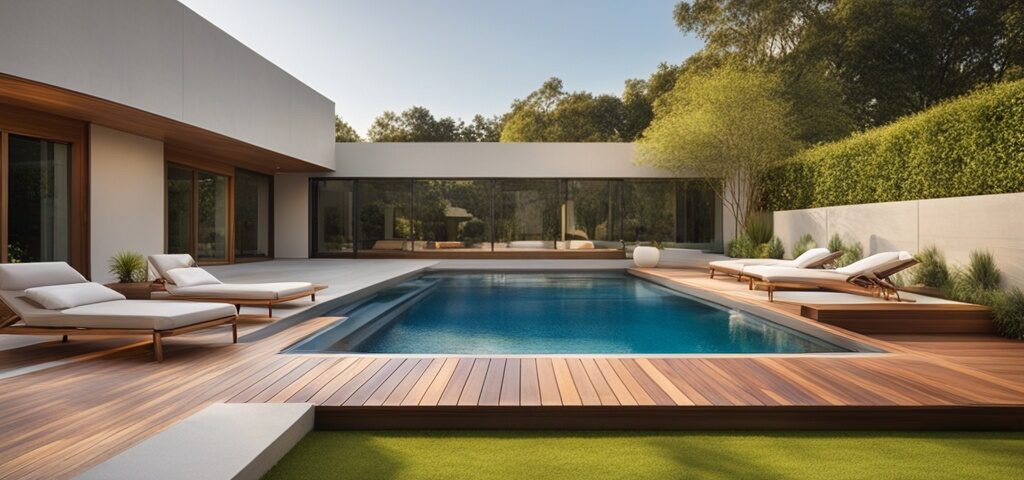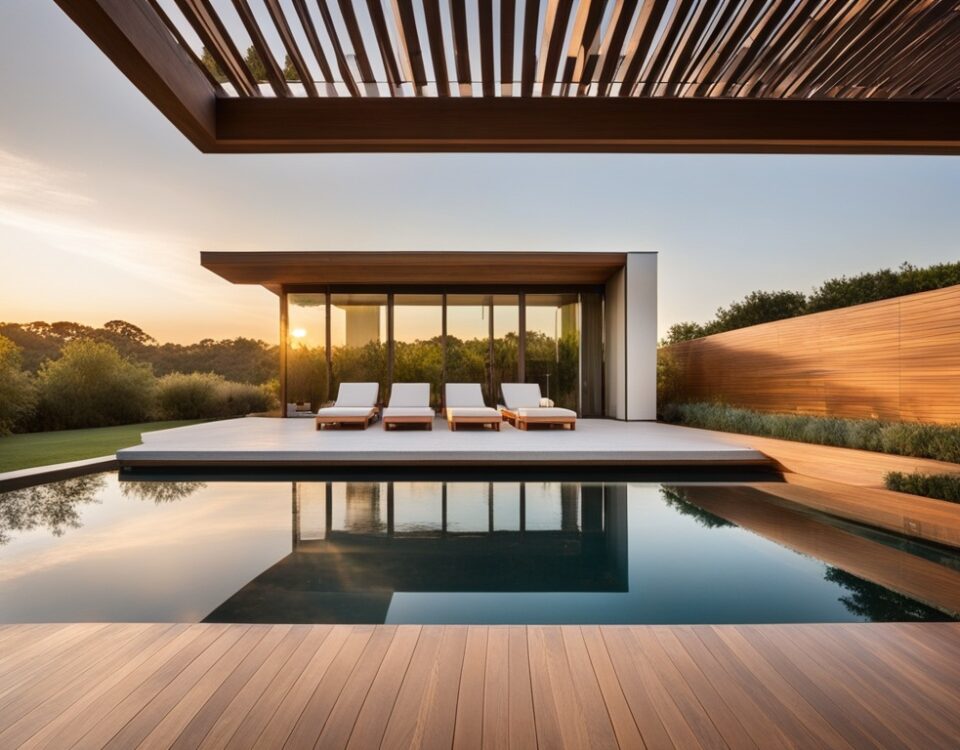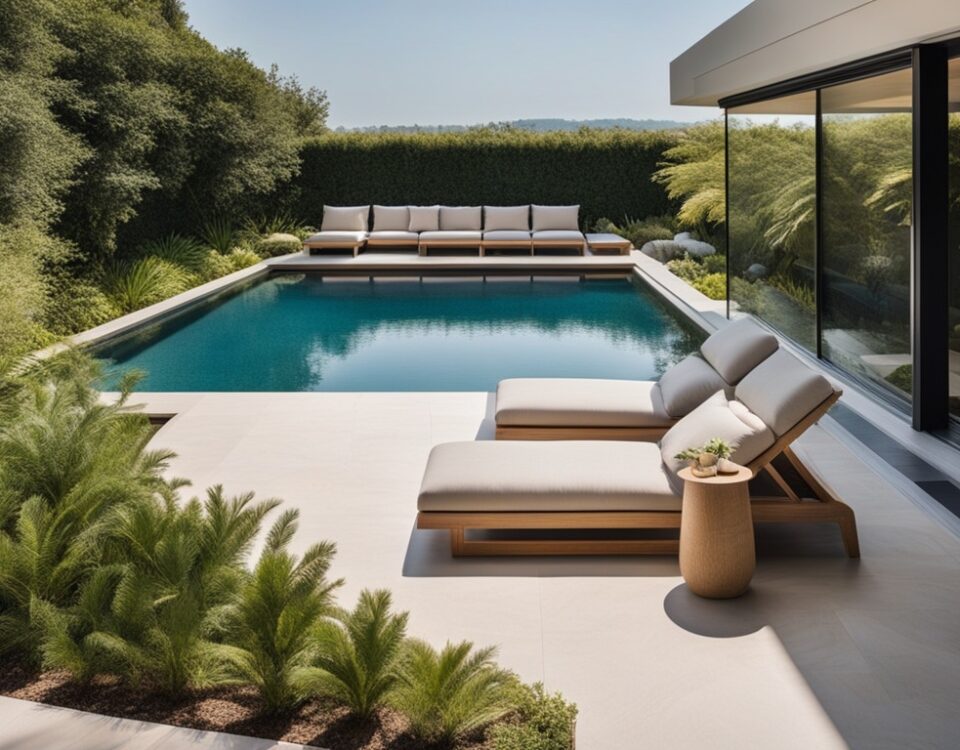Ultimate Guide: Selecting the Top Pool Deck Materials for Your Oasis

Filter Battle: Sand vs Cartridge – The Ultimate Showdown
May 9, 2025
Sleek Serenity: 10 Minimalist Pool Design Ideas to Transform Your Space
May 9, 2025Overview of Pool Decks Materials
Choosing the right materials for your pool deck is *paramount* in achieving both functionality and aesthetic appeal. A well-designed pool deck not only enhances the overall beauty of your backyard oasis but also plays a critical role in safety, maintenance, and longevity. The right materials will ensure durability against the elements while providing a comfortable, slip-resistant surface that complements your pool’s design.
One of the main considerations in selecting pool deck materials is the climate of your region. Certain materials may flourish in sunnier, warmer environments, whereas others may withstand freezing temperatures and snow. Furthermore, the deck should be comfortable underfoot and not become excessively hot when exposed to direct sunlight, contributing to an enjoyable poolside experience.
Main Types of Pool Deck Materials
When delving into the options available for pool decking, several primary materials stand out:
- Concrete: A *popular choice* due to its versatility and cost-effectiveness, concrete can be customized with various textures and colors. It provides a solid surface that supports heavy foot traffic and can be treated with non-slip coatings for added safety.
- Wood: A classic and *natural* option, wooden decking exudes warmth and elegance. However, it requires regular maintenance to protect against water damage and fading. Treatments such as sealants can extend its lifespan.
- Pavers: Available in various materials, such as brick, stone, and concrete, pavers offer an *aesthetic charm* along with flexibility in design. They provide excellent drainage and are easy to replace if damaged.
- Composite Decking: Made from a blend of wood fibers and plastic, composite decking offers the *aesthetic of wood* without the drawbacks of traditional materials. It is designed to resist fading and splintering, making it a low-maintenance option.
- Natural Stone: Materials such as flagstone, slate, and travertine lend a *luxurious feel* to your pool area. While often more expensive, their unique colors and textures create a stunning visual appeal. These stones are naturally cool to the touch, enhancing comfort in hot weather.
Understanding the characteristics of each of these materials will guide homeowners in making an informed decision suited to their specific needs and preferences. Whether prioritizing style, durability, or maintenance, a thoughtful selection will yield a beautiful and functional pool deck for years to come.
Concrete Pool Decks
When it comes to choosing a pool deck material, concrete stands out as one of the most popular options due to its versatility, durability, and cost-effectiveness. However, like all materials, it has its own set of advantages and disadvantages worth considering before making a final decision.
Advantages and Disadvantages of Using Concrete for Pool Decks
One of the primary advantages of concrete pool decks is their longevity. Concrete is known for its exceptional strength, allowing it to withstand the elements and heavy foot traffic without showing much wear and tear. Furthermore, it is relatively low-maintenance, requiring only periodic cleaning and sealing to keep its aesthetic appeal.
On the flip side, one of the notable disadvantages of concrete is its tendency to absorb heat, which can make the surface uncomfortably hot underfoot during the sweltering summer months. Additionally, while concrete is generally resistant to cracking, it is not entirely immune; temperature fluctuations and improper installation can lead to unsightly cracks over time.
Different Finishes and Styles Available for Concrete Pool Decks
Concrete pool decks offer a range of finishes and styles that can elevate the overall visual appeal of your outdoor space. A few popular options include:
- Stamped Concrete: Mimicking the appearance of natural stone, stamped concrete enhances aesthetics while retaining all the benefits of standard concrete.
- Exposed Aggregate: This finish provides a unique texture by removing the top layer of cement, revealing colorful stones and pebbles underneath.
- Colored Concrete: By mixing pigments into the concrete, homeowners can achieve stunning hues that match their landscaping or home exterior.
- Smooth Finish: This option offers a sleek appearance that is also easier to clean, though it may be more slippery when wet.
Tips for Maintaining and Caring for a Concrete Pool Deck
To ensure the longevity of your concrete pool deck, implementing a regular maintenance routine is crucial. Here are some useful tips:
- Routine Cleaning: Use a mild detergent and a power washer to clean your deck several times a year, removing dirt, algae, and debris that can cause staining.
- Sealant Application: Applying a high-quality sealant every couple of years helps protect against moisture and boosts longevity. This is especially important in climates with freezing temperatures.
- Monitor for Cracks: Keep an eye out for any cracks. If noticed, addressing them quickly with a concrete repair product can prevent water infiltration and further damage.
- Use Rugs and Mats: Placing rugs or mats in high-traffic areas can help reduce wear and tear while also providing a non-slip surface.
| Maintenance Task | Frequency |
|---|---|
| Routine Cleaning | Every 3-6 months |
| Sealant Application | Every 2 years |
| Inspection for Cracks | Monthly |
In conclusion, while concrete pool decks present some challenges, their benefits and customizable options make them a compelling choice for many homeowners looking to enhance their pool area.
Wood Pool Decks
Choosing wood as a material for pool decks presents a blend of aesthetic appeal and practical performance. The *natural warmth* and *beauty* of wood can enhance any backyard environment, providing a harmonious connection with nature. However, potential buyers should consider both the benefits and drawbacks of wood when evaluating it for their poolside paradise.
Benefits and Drawbacks of Wood as a Pool Deck Material
One of the foremost benefits of wood pool decks lies in their *timeless beauty*. Wood offers a wide range of colors and grains, allowing homeowners to tailor their outdoor space to their personal style. Additionally, wood is a warm material that feels comfortable underfoot, preventing the sweltering sensation often experienced with concrete or tile.
However, *wooden decks* come with notable drawbacks. They are susceptible to the elements, including moisture, UV rays, and temperature fluctuations, which can lead to *splintering*, *warping*, and *fading*. Without proper maintenance, wood can also become a breeding ground for mold and mildew, particularly in humid climates.
Popular Types of Wood Used for Pool Decks
When selecting wood for pool decks, some varieties stand out for their durability and resistance to water damage. Below are a few popular options:
| Type of Wood | Characteristics |
|---|---|
| Composite Decking | Made from recycled wood and plastic, it mimics the appearance of natural wood while offering superior moisture resistance. |
| Teak | Renowned for its *natural oils*, teak is exceptionally durable and resists water damage, making it a popular choice for luxury pool decks. |
| Cedar | Lightweight and aromatic, cedar is naturally resistant to decay but requires more maintenance than hardwood options. |
| Ipe | This dense hardwood is known for its *incredible durability* and resistance to rot, making it an excellent choice for poolside installations. |
Considerations for Climate and Maintenance with Wood Pool Decks
Climate plays a vital role in the longevity of wood pool decks. In *humid areas*, regular sealing and maintenance are essential to prevent rot and mold. Alternatively, in regions with *intense sun exposure*, UV-protective coatings can mitigate fading and prolong the deck’s aesthetic appeal. Homeowners should schedule routine inspections to address any signs of wear or damage promptly.
To maintain a wood deck, it is advisable to clean surfaces regularly and apply protective stains or sealants every few years. A proactive approach to maintenance can significantly extend the life of the deck while ensuring it remains a beautiful gathering place for family and friends.
Composite Pool Decks
Composite decking is a modern, innovative material composed of a blend of wood fibers and recycled plastic. This unique combination not only offers the aesthetic appeal of traditional wood but also significantly enhances the durability and resistance of pool decks. As homeowners increasingly recognize the myriad benefits of composite materials, the popularity of composite pool decks has surged in recent years, reflecting a growing trend towards sustainable and low-maintenance outdoor solutions.
Advantages Over Traditional Wood and Concrete Pool Decks
One of the most compelling reasons to choose composite decking for your pool area lies in its *superior resistance* to moisture and weathering. Unlike traditional wood, which can warp, splinter, or rot when exposed to water, composite decking remains stable and intact, providing a *safer and more comfortable* environment around your swimming pool. Moreover, due to its composition, composite material is typically less slippery than concrete when wet, adding an extra layer of safety for swimmers and sunbathers alike.
Another noteworthy advantage is the *low maintenance* aspect that composite decking offers. Unlike wood, which requires regular staining, sealing, and treatment to prevent decay and insect infestations, composite materials merely require routine cleaning with soap and water to maintain their appearance. This reduction in maintenance efforts not only saves time but also provides cost-effectiveness over the lifespan of the deck. When weighing the expenses of upkeep, many homeowners find that composite decking ultimately proves to be the more economical choice.
Installation of Composite Pool Decks
Installing a composite pool deck can be a straightforward process, especially when compared to traditional materials. Many composite decks come with a simple interlocking system that can save both time and labor costs during installation. However, for the best results, it is often recommended that homeowners enlist the expertise of professionals familiar with the specific brand and type of composite materials. Proper installation ensures optimal spacing and alignment, which is crucial for drainage and overall structural integrity.
Maintenance Tips for Composite Pool Decks
| Maintenance Task | Frequency |
|---|---|
| Power wash | Once a year |
| Clean with soap and water | As needed |
| Inspect for damage | Twice a year |
| Apply a protective sealant | Every 3-5 years |
To maximize the longevity and beauty of your composite pool deck, adhere to a few maintenance tips. Perform a *power wash* annually to eliminate dirt and debris buildup, ensuring that your outdoor space remains visually appealing. Routine inspections should be conducted biannually to identify any potential damage, such as fading or warping. Finally, consider applying a protective sealant every three to five years to preserve the color and enhance the material’s durability against elements. Following these simple yet effective maintenance guidelines will ensure that your composite pool deck remains a centerpiece of your home for years to come.
Stone Pool Decks
When it comes to creating an inviting and elegant atmosphere around your swimming pool, stone pool decks stand out as a premier option. The natural beauty and versatility of stone make it an attractive choice for many homeowners. Among the various types of stone used for pool decks, *travertine*, *limestone*, and *slate* are particularly notable for their unique characteristics and aesthetic appeal.
Types of Stone for Pool Decks
Travertine, known for its *warm earthy tones*, is a naturally occurring stone formed from mineral deposits. It is a favorite in the pool decking arena due to its ability to remain cool underfoot even on the hottest days, making it comfortable to walk on. Another popular choice is limestone, celebrated for its *soft texture and subtle hues*, which can create a serene ambiance around the pool area. Lastly, slate offers a more rugged aesthetic; its *variegated colors and textures* evoke a sense of natural beauty, making it a distinctive option for those looking to enhance their outdoor space.
Durability and Aesthetic Appeal
Stone pool decks are renowned for their impressive *durability*. When properly installed, stone can withstand extreme weather conditions and resist the wear and tear that often accompanies a high-traffic area. Moreover, the aesthetic appeal of stone is unparalleled; each type of stone exhibits unique patterns and colors, allowing homeowners to create a personalized look that complements their landscape. The natural variations in stone provide a *timeless charm*, ensuring that the pool deck enhances rather than detracts from the pool’s landscape.
Cost Considerations
While the allure of stone pool decks is undeniable, it is essential to consider the cost factors involved. Generally, the installation of stone decks can be more expensive than other materials, primarily due to the higher costs of materials and labor. Prices can range from *$15 to $30 per square foot*, depending on the type of stone and the complexity of the installation. While this may seem steep, many homeowners find that the *long-term benefits of durability and aesthetic appeal* justify the initial investment.
Maintenance Requirements
In terms of maintenance, stone pool decks require some attention to keep them looking their best. Regular cleaning is advisable to prevent the buildup of algae and grime, especially in areas with high humidity. Sealing the stone every few years will also protect it from stains and preserve its natural beauty. While stone requires more maintenance than some synthetic options, its *timeless elegance* and *robust durability* make it a worthwhile consideration for discerning homeowners.
| Type of Stone | Durability | Aesthetic Appeal | Cost per Square Foot |
|---|---|---|---|
| Travertine | High | Warm tones, natural appeal | $15 – $25 |
| Limestone | Moderate to High | Soft, serene hues | $10 – $20 |
| Slate | High | Rugged, variegated textures | $20 – $30 |
Tile Pool Decks
Tile pool decks offer a remarkable combination of *style*, *durability*, and *functionality*, making them an exceptional choice for homeowners looking to enhance their outdoor spaces. One of the primary benefits of using tile for pool decking is its inherent *resistance to water and moisture*, which is critical in a pool environment. Tiles can withstand harsh weather conditions, resist fading from sunlight, and are less prone to cracking compared to other materials. Furthermore, their non-slip properties enhance safety, ensuring that the deck remains both aesthetically pleasing and functional even when wet.
Types of Tiles Suitable for Pool Decks
When considering tile options for pool decks, several materials stand out for their compatibility with aquatic environments:
| Type of Tile | Advantages | Disadvantages |
|---|---|---|
| Porcelain Tiles | Highly durable, low porosity, resistant to stains | Can be slippery when wet, requires proper installation |
| Ceramic Tiles | Available in various designs, cost-effective | More vulnerable to cracking than porcelain |
| Glass Tiles | Luxurious appearance, color-rich options, reflective qualities | Higher cost, installation can be complicated |
Porcelain tiles are particularly recognized for their *unmatched durability* and *low porosity*, making them an ideal choice for harsh poolside conditions. They effectively resist stains and do not absorb moisture, further enhancing their longevity. On the other hand, ceramic tiles often entice homeowners with their *affordability* and *wide range of colors and patterns*, though they tend to be less durable compared to their porcelain counterparts. Glass tiles, while more expensive, offer a luxurious aesthetic with *iridescent finishes* that can beautifully reflect sunlight, contributing to a vibrant poolside atmosphere.
Design Options and Customization Possibilities
One of the most alluring aspects of tile pool decks is the extensive range of design options they present. Homeowners can select from a veritable *symphony of colors*, patterns, and textures, allowing for a truly *customized look*. For instance, geometric patterns can create a modern, sophisticated feel, while natural stone textures can evoke a rustic charm. Additionally, tiles can be arranged in *mosaics*, enabling creative expressions that complement the surrounding landscape and pool design.
Another dimension of customization lies in the grout selections; different grout colors can dramatically change the *visual impact* of the tiled surface. Lighter grouts can enhance the brightness of the tiles, while darker grouts provide a more unified appearance. Moreover, many tiles can be shaped or cut to fit unique pool configurations, allowing for a seamless integration between the pool and deck area. The versatility of tile materials extends well beyond mere aesthetics, providing the opportunity to tailor your pool deck to match your personal style and landscaping goals.
Other Pool Deck Materials
Alternative Pool Deck Materials
When considering the ideal pool deck materials, one should explore a variety of alternatives that can enhance both aesthetics and functionality. Among these, *rubber, brick,* and *pavers* stand out for their unique characteristics. Rubber decking is particularly appealing due to its slip-resistance and cushioning properties, making it a safe choice for households with children and elderly individuals. On the other hand, brick offers a classic aesthetic; its *durability* and ability to withstand varying weather conditions make it a popular choice for many homeowners. Lastly, pavers, with their broad design versatility, provide an opportunity for creative landscaping while being highly resilient to water damage.
Unique Characteristics
Each alternative material comes with its own set of attributes worth considering. Rubber decking is often available in various colors and textures, allowing for customization to match the pool’s surroundings. It is also resistant to mold and mildew, which can be significant in humid climates. Brick, revered for its *timeless appeal,* can handle heavy foot traffic and retains its structural integrity over time, making it a reliable investment. Pavers can be arranged in countless patterns, providing an aesthetic flexibility that can transform a conventional pool area into a work of art. Moreover, they facilitate drainage, thus minimizing water accumulation that can lead to slippery conditions.
Installation Considerations
Installation methods differ between these materials, impacting both cost and maintenance. Rubber pool decks are generally easier to install; they can be laid over existing surfaces, reducing labor costs. Conversely, brick and paver installations typically require a solid foundation and proper alignment, necessitating the expertise of professional installers. It is crucial to prepare the substrate appropriately, as improper installation can result in uneven surfaces or premature wear. Homeowners should also bear in mind the potential need for sealing pavers and bricks to protect against stains and weathering.
Choosing the Best Material
When it comes to selecting the optimal pool deck material, consider the *specific needs* and *preferences* of your environment. Factors such as *climate,* usage patterns, and design goals play significant roles in determining the right choice. For instance, if your region experiences heavy rainfall or snow, opting for materials that provide excellent drainage and are resistant to temperature fluctuations, like pavers, would be prudent. On the other hand, if budget constraints are a primary concern, rubber might offer the most practical combination of safety and cost-effectiveness.
Cost Comparison
| Material | Average Cost per Square Foot | Durability | Maintenance Level |
|---|---|---|---|
| Rubber | $5 – $10 | High | Low |
| Brick | $7 – $15 | Very High | Medium |
| Pavers | $10 – $20 | High | Medium |
Long-Term Considerations
Finally, it’s essential to think long-term when investing in pool deck materials. While upfront costs are important, consider the lifespan and potential repair needs of each option. Rubber may wear down over time, necessitating surface replacements or patches. Brick, while incredibly durable, may require periodic repointing, whereas pavers often only need re-leveling if settled unevenly. By evaluating both initial costs and future maintenance, homeowners can make a well-informed decision that aligns with their *aesthetic desires* and *functional needs*.
Learn more about Swimming Pool

Javier Morales is passionate about pool design, maintenance, and outdoor living. With years of hands-on experience, he offers practical tips, creative ideas, and expert insights to help readers make the most of their pool spaces. At Piscina Planet, Javier shares everything from seasonal care guides to the latest trends in pool innovation.




